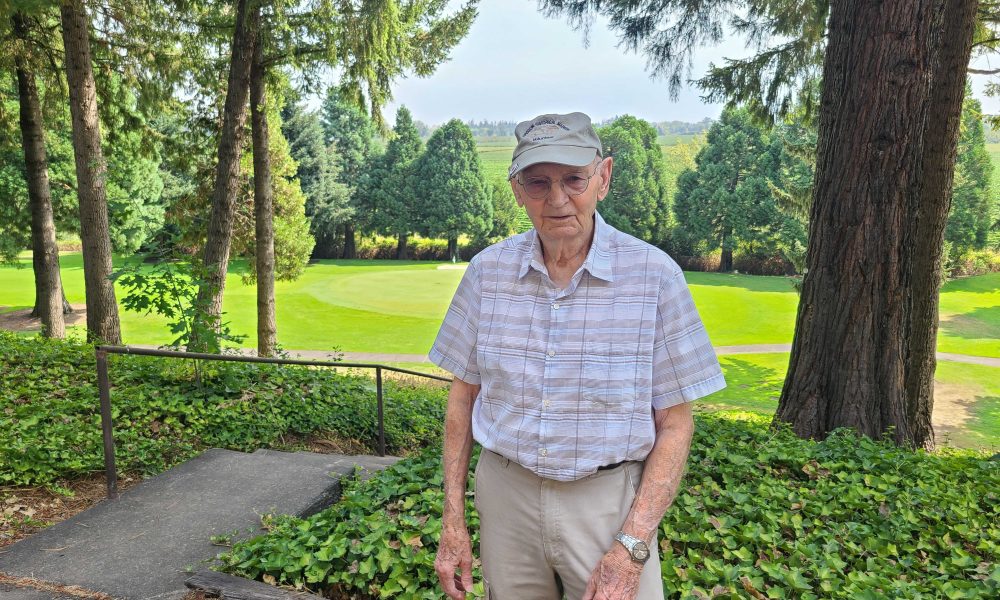From the Oregon Coast to the far reaches of Wallowa and Malheur Counties, over a hundred historical wooden signs with white lettering are visible on the sides of highways, atop hills and on walking paths.
For over three decades, a group of volunteer woodworkers in a Salem retirement community has maintained them all.
Jack Carroll leads the group of 12, who take road trips to each sign once every three years or so to either make repairs onsite or haul it back to their workshop at Salemtowne 55+ community in west Salem.
“If it wasn’t for us, there wouldn’t be any more signs. And they’re important,” Carroll said.
The markers are likely familiar to anyone who has driven in the state. The signs are wood, with white letters and a beaver at the top. Each has site-specific information underneath.
Many of the markers were created in the 1950s, according to the state’s Travel Information Council. In 1991, when the council took over the program, many were deteriorating and the council struggled to keep up with maintenance.
That year, Salemtowne resident Dick Ackerman joined the state’s Oregon Historical Marker Committee and talked his friends into joining the cause to revitalize the signs. Ackerman has since died, but laid the foundation for the work to continue for years to come.
When Ackerman started, Salemtowne didn’t have a designated sign repair shop, but Ackerman asked to turn an unused space in a community building’s garage into a full-service center for the signs.

Decades later, Carroll, now the third person to lead the group, stood in a woodworking space with tools lining the walls and a sign on the door reminding people that the supplies inside belong to the state.
Carroll used to be a woodshop teacher in Harrisburg, and when he moved to Salemtowne about 18 years ago, he thought the restoration group would be a good way to put his skills to use and learn more about the history of the state. He’s been the group’s foreman for over a decade, organizing trips and catering to the strengths of each member.
Of the group of 12, eight take road trips throughout the state to check in on signs, with a goal of revisiting each at least every three years.
“We never know what we’re going to find until we get to the job,” Carroll said.
The first step in restoration is to clean off the sign, removing loose paint from the letters and filling in holes and cracks. They then apply three coats of brown stain to the back of the sign, and repaint the white letters. Carroll shared a two page, all caps instruction sheet that specifies the sign dimensions and the types of paint and foam brush to be used for renovation.
Many signs, like one in Scappoose last week, can be refinished on site, with passersby walking up to ask the group what they’re up to or thank them for their work.
They’ll rent a van or two for the journey, and the state pays for their gas, food and lodging when necessary, though Carroll said the group always tips their servers at least 20% by digging cash from their own pockets. They tackle the signs a region at a time, with some trips lasting a full day and others with a night in a hotel.
“The guys all understand we need to work and not think about, ‘Well, where are we going to have coffee?’ or whatever. We’re good about staying on the job,” Carroll said.
The work has taken Carroll to places he never would have seen otherwise, and the group has endured mosquito bites in the field – with one volunteer getting 40 on each leg during an unfortunate outing in Bly.
“The sign was in good shape, so we just did what we had to do and got out of there,” he said.
Though he’s always had an interest in history, the work has taught Carroll new things. He hadn’t previously known the history of the World War II Japanese balloon bomb that killed six people in Bly, and has learned more about Chief Joseph, leader of the Nez Perce in the 19th century.
“They’re all interesting, it’s just some stand out,” Carroll said.
On Aug. 1, the Travel Information Council held its annual luncheon at the Salemtowne Community Hall to celebrate the group’s work. Carroll said he enjoys visiting the state agency’s office where the staff treat him and the other volunteers like royalty.
Ultimately, though, he does the work for the sake of teaching visitors more about Oregon history.
“I feel like it’s our contribution, to be able to help visitors coming to the state that are interested in some of the history, and I feel like a big part of that,” he said.
Carroll, who turns 91 in September, plans to keep at it.
“I’m an old timer, but I try to keep going. This is part of what keeps me going,” he said.
A map of the markers is visible online. The nearest site to Salem is for James Nesmith, a leader in early Oregon government, at the Polk County Fairgrounds in Rickreall.

Contact reporter Abbey McDonald: [email protected] or 503-704-0355.
SUPPORT OUR WORK – We depend on subscribers for resources to report on Salem with care and depth, fairness and accuracy. Subscribe today to get our daily newsletters and more. Click I want to subscribe!

Abbey McDonald joined the Salem Reporter in 2022. She previously worked as the business reporter at The Astorian, where she covered labor issues, health care and social services. A University of Oregon grad, she has also reported for the Malheur Enterprise, The News-Review and Willamette Week.









